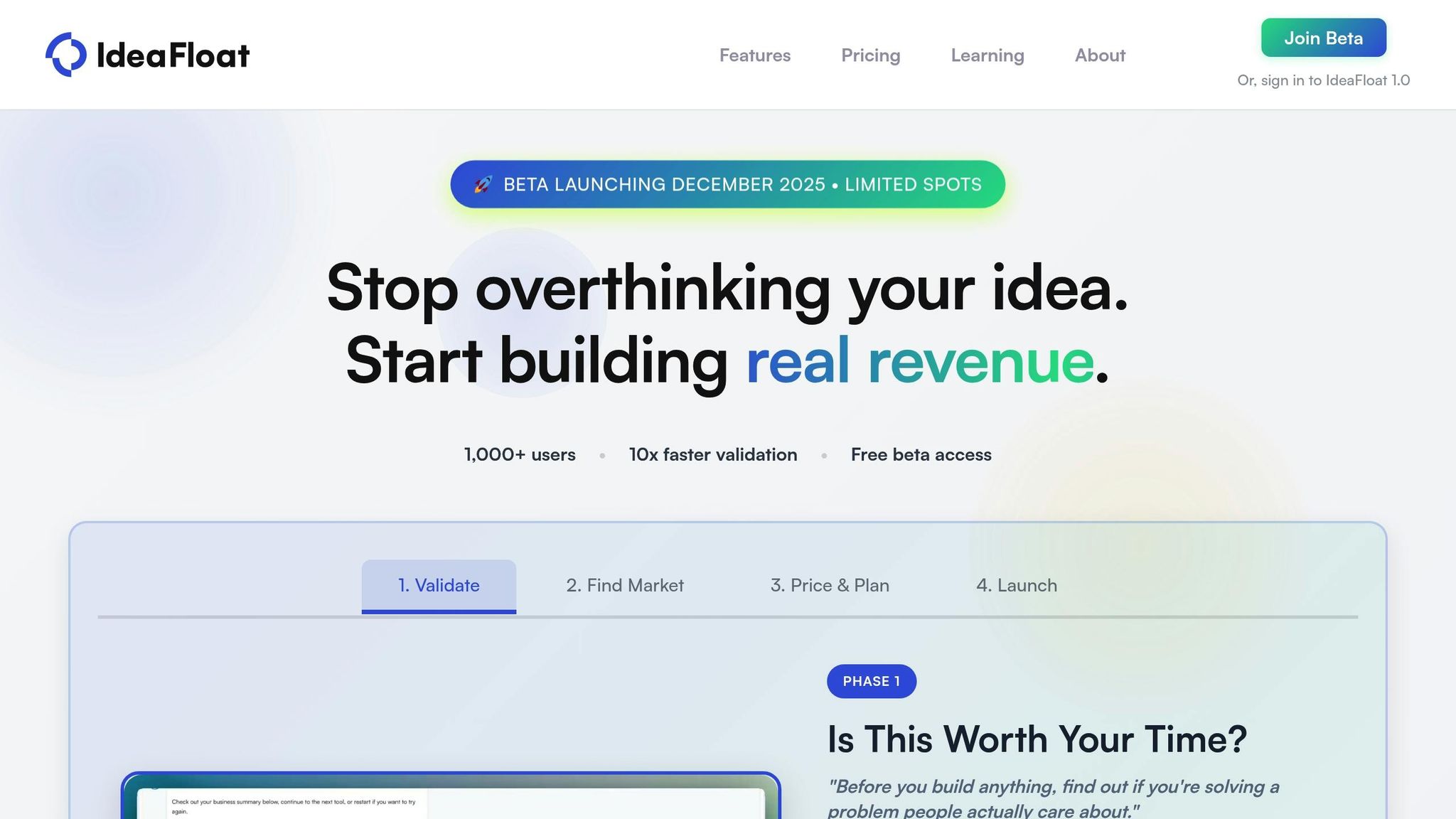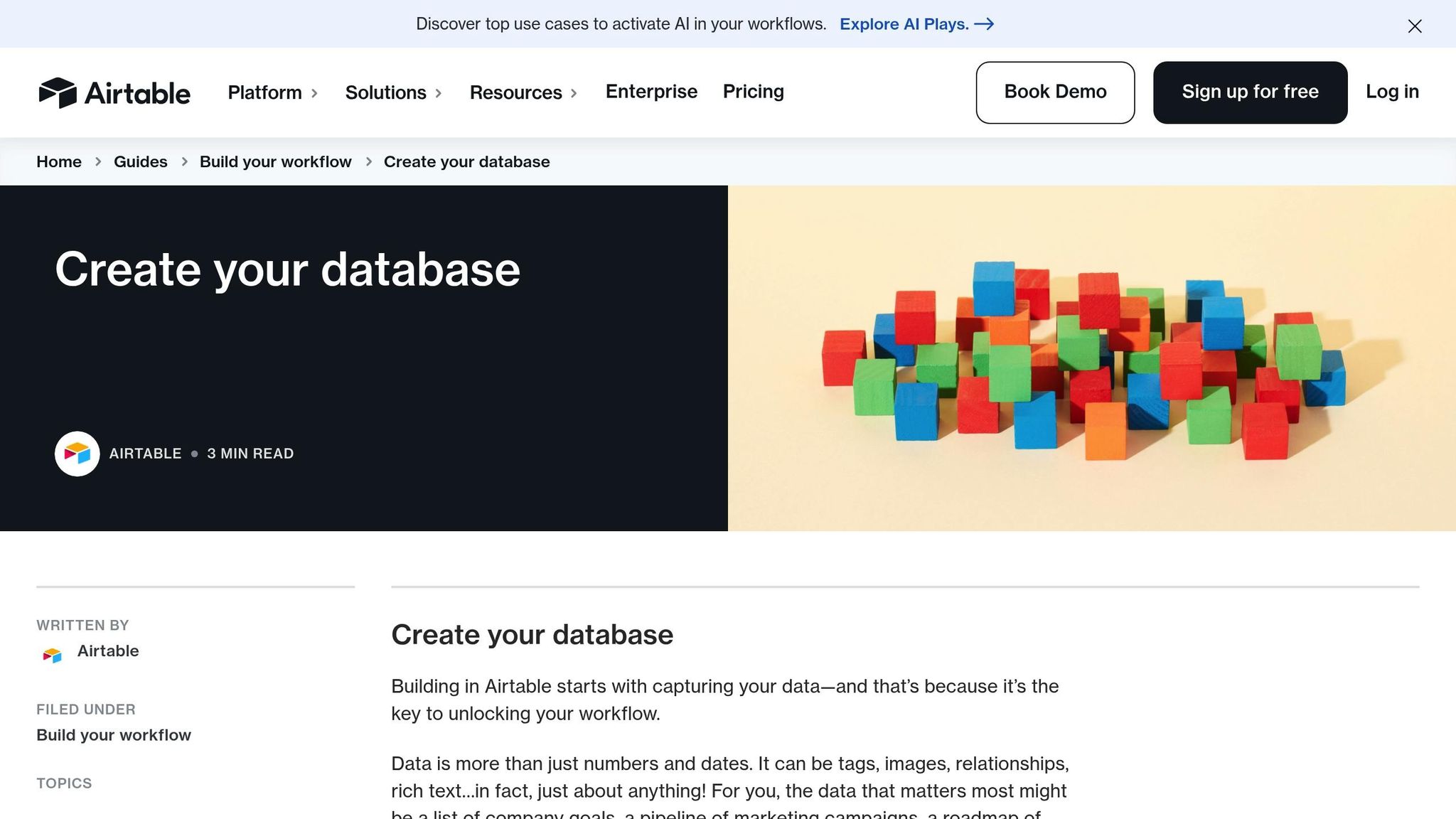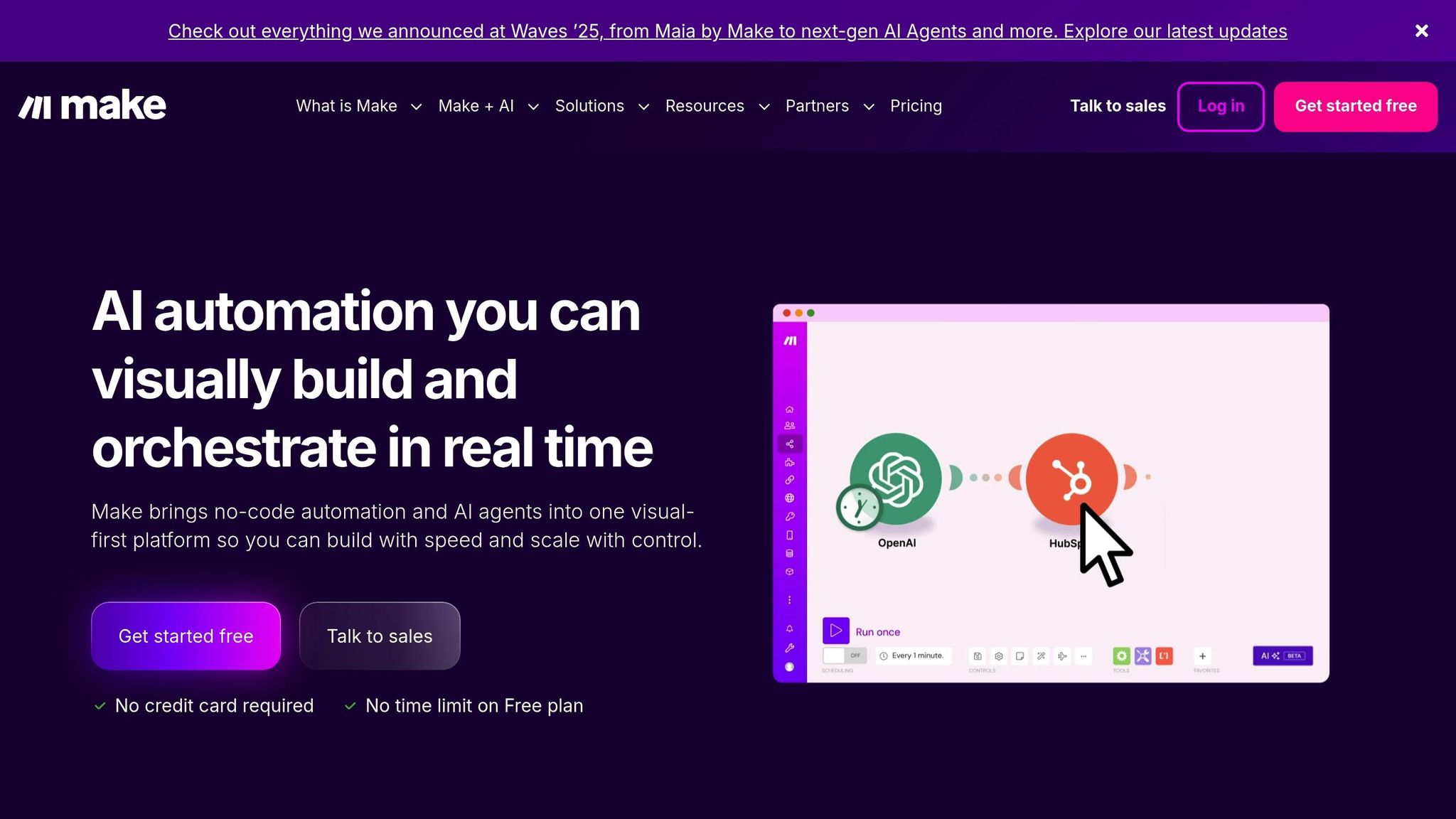
Creating a business plan no longer has to take months or cost a fortune. By combining no-code platforms with AI tools, you can automate up to 80% of the research process - saving time, cutting costs, and improving accuracy. Here's how these tools simplify tasks like market analysis, competitor tracking, customer insights, and financial modeling:
- AI handles tedious research tasks: From analyzing market trends to summarizing competitor data, AI tools work faster and more consistently than manual methods.
- No-code platforms require no technical skills: Build workflows in days, not months, without writing a single line of code.
- Key benefits: Faster research, reduced costs, fewer errors, and workflows you can adjust in real time.
Think of these tools as your research assistant, gathering and organizing data so you can focus on decision-making. While automation does the heavy lifting, human judgment remains essential for interpreting results and shaping strategies. Ready to speed up your business planning process? Let’s dive into the details.
👉 5 BEST AI Tools To Create a Winning Business Plan
How No-Code + AI Changes Business Plan Research
The way entrepreneurs tackle business planning has been completely transformed by the introduction of AI-powered automation. Gone are the days when research required technical know-how, lengthy timelines, and hefty budgets. Thanks to no-code AI platforms, business owners can now create efficient, intelligent research workflows in just a few days instead of months. This shift not only speeds up the process but also reshapes the role of experts in planning.
This revolution puts the power back in the hands of those who know the business best. As Allganize explains:
No-Code AI Automation... is about empowering Subject Matter Experts (SMEs), the people who best understand the business problems to build and deploy intelligent AI agents without writing a single line of code.
The benefits of this approach are clear and substantial:
Main Benefits of Research Automation
Speed as a Competitive Advantage. Research tasks that once dragged on for weeks can now be completed in mere minutes. AI consultant Ben Van Sprundel highlights this flexibility:
Why I love Relevance AI? Even though it's a no-code platform the use cases are unlimited and you can customize it any way you want and DO anything you want.
Cost Savings. By cutting out the need for specialized developers and long implementation processes, businesses can redirect funds toward growth. No-code platforms remove the high costs and complexities that previously slowed progress.
Improved Accuracy Through Consistency. AI agents handle research tasks with uniform precision, reducing human errors and delivering reliable data every time.
Real-Time Customization. Unlike traditional systems that require developer input for changes, no-code platforms let users tweak workflows through simple settings. This ensures research processes can adapt as business priorities evolve.
Greater Autonomy. With less reliance on IT teams, business units can experiment freely with new research strategies and make immediate improvements.
Research Tasks You Can Automate
Here’s where no-code AI truly shines, taking over tasks that once required countless hours:
- Market Analysis and Sizing: AI agents can comb through industry reports, government databases, and market research to calculate Total Addressable Market (TAM), Serviceable Addressable Market (SAM), and Serviceable Obtainable Market (SOM) using reliable sources.
- Competitor Mapping and Analysis: Keep tabs on competitors in real time - track their website updates, pricing adjustments, product launches, and marketing campaigns to stay ahead of the curve.
- Customer Insights Gathering: Go beyond surveys. AI can analyze social media chatter, reviews, forums, and more to uncover customer pain points and emerging trends.
- Trend Identification and Forecasting: By connecting data from sources like industry reports, patent filings, and consumer behavior, AI spots trends before they hit the mainstream.
- Financial Modeling and Projections: Move beyond static spreadsheets with dynamic, data-driven models. AI integrates real-time pricing, cost benchmarks, and industry data for sharper financial forecasts.
- Regulatory and Compliance Research: AI agents can continuously monitor regulatory updates and legal databases, ensuring your business stays compliant with the latest standards.
What sets this approach apart is the autonomy of AI agents. These tools don’t just assist - they handle entire research workflows independently, delivering results in formats that make decision-making faster and easier.
5 Phases of Business Plan Research and Automation Options
Crafting a solid business plan involves five key research phases. With the help of no-code platforms and AI tools, these phases can be transformed into efficient, automated workflows. What once required days of manual effort can now be completed in minutes. Each phase builds on automated insights, helping you make decisions faster and with greater confidence. Here’s how automation can enhance each step of your business plan research.
Phase 1: Problem Validation and Customer Research
The first step is to ensure your idea addresses a real market need. AI tools simplify this process by quickly analyzing customer feedback from various online platforms. These tools can quantify common complaints and identify recurring pain points, giving you a clear picture of what customers want. This approach is not only faster but also provides a broader perspective compared to traditional methods. By keeping your market data up to date, automation ensures your insights remain accurate and actionable.
Phase 2: Competitor Analysis and Market Gap Research
Understanding your competition is crucial, and automated tools excel at gathering this data. They scan online sources to map out competitors and identify those tackling similar challenges. By monitoring key metrics like pricing changes and product updates, these tools create an evolving database of competitor information. This dynamic analysis helps pinpoint underserved market segments, allowing you to position your business more strategically.
Phase 3: Market Size and Opportunity Calculations
Estimating market potential can be a complex task, but AI platforms make it straightforward. They aggregate data from trusted sources to calculate metrics like Total Addressable Market (TAM), Serviceable Addressable Market (SAM), and Serviceable Obtainable Market (SOM). These automated calculations reflect the latest market conditions and cross-reference broader indicators to validate opportunities. The result? A more reliable and up-to-date foundation for your business plan.
Phase 4: Go-to-Market Strategy Development
Developing a go-to-market strategy involves identifying the best customer acquisition channels, crafting effective messaging, and planning launch activities. AI tools can analyze where your target audience is most active and estimate acquisition costs using real-world data. Additionally, these tools can generate customized marketing content and detailed launch schedules, saving you time and effort. This automation allows you to focus on the creative and strategic aspects of your launch.
Phase 5: Financial Models and Business Feasibility
The final phase evaluates whether your business idea can be profitable. Instead of static spreadsheets, AI tools create dynamic, real-time financial models. These systems pull from current pricing and industry benchmarks to produce accurate expense projections. They also enhance revenue models by incorporating live customer acquisition data. Automated sensitivity testing and breakeven analysis help identify crucial financial variables and potential risks.
For example, advanced workflows - like the n8n template with its 83 intelligent agents - can generate comprehensive financial and operational strategies in just minutes. Throughout these phases, the "30% AI rule" is a helpful guideline: use AI for gathering initial data and rely on human expertise for key strategic decisions.
Best No-Code + AI Tools for Business Plan Research
No-code and AI tools are game-changers for business research, simplifying how you gather, analyze, and organize data. They free up your time so you can focus on crafting strategies and making decisions. Here’s a look at some standout tools that can streamline your business plan research.
IdeaFloat: All-in-One Business Validation Platform

IdeaFloat is a comprehensive platform designed to help you validate and build your business idea faster. It combines AI-driven research with tools tailored to every stage of business planning.
- Problem Validator: Checks if your idea solves a real problem that people are willing to pay to fix.
- Consumer Insights: Scans online conversations to gather authentic customer feedback.
- Smart Market Sizing: Calculates TAM, SAM, and SOM using reliable data.
- Conversational AI: Acts like a co-founder, letting you brainstorm and refine ideas interactively instead of filling out static forms.
- Go-to-Market Strategy: Identifies customer acquisition channels and provides ready-to-use outreach templates.
- Financial Modeling: Generates projections to help you understand when profitability might be within reach.
- Launch-Ready Features: Offers tools like professional logos, waitlist pages, and detailed launch checklists.
Pricing starts with a free plan, while paid options are available at $20/month for the Standard plan and $40/month for Pro.
Airtable: Custom Research Database Tool

Airtable helps you create a dynamic research database to manage competitor tracking, customer feedback, trend analysis, and financial data. Its integrations make it easy to pull data from multiple sources into one central hub, while automation features handle repetitive tasks seamlessly.
Notion AI: Research and Content Creation Workspace

Notion AI combines note-taking, database management, and AI-powered content generation in one place. It can summarize lengthy market reports, competitor analyses, or customer research, making complex information more digestible. Plus, its content creation tools can help you draft polished sections of your business plan. Pre-built templates for various tasks save time and keep your workflow organized.
Zapier: Automating Tool Connections and Data Transfers

Zapier connects your favorite tools, automating data transfers and eliminating manual updates. With access to over 5,000 apps, you can set up workflows that update databases, monitor market trends, or pull insights from industry news - all without writing a single line of code.
Make: Advanced Automation for Complex Workflows

Make, previously known as Integromat, takes automation to the next level. Its visual workflow builder allows you to create multi-step processes with conditional logic, making it perfect for handling complex tasks like processing customer feedback or updating financial models. It also excels at managing large datasets, thanks to advanced error handling and processing capabilities.
sbb-itb-08dd11e
How to Build Your Automated Research Workflow
Creating an automated research workflow that works seamlessly with your business planning process takes thoughtful preparation and the right tools. The idea is to start simple, define your goals clearly, and gradually add layers of sophistication as needed.
Step 1: Set Research Goals and Define Scope
Before diving into tools or techniques, start by outlining your research objectives. Are you trying to validate a problem? Assess your competition? Size up your market? Each goal will require different data sources and methods.
Prioritize the research phases based on your business type. For B2B endeavors, competitor analysis and market sizing should take center stage. If you're targeting consumers, customer research and go-to-market strategies might be more critical.
Next, create a research timeline that fits your overall planning schedule. For instance, if you aim to complete your business plan in six weeks, allocate time for each phase - two weeks for problem validation, one week for financial modeling, and so on, depending on the tools you use.
Set clear benchmarks to measure the quality of your research. For example, you might require a specific number of competitor profiles or a certain sample size for customer insights. These benchmarks will guide how you configure your automation tools.
Once your goals and scope are clear, you’re ready to pick tools that align with your needs.
Step 2: Select Tools and Configure Workflows
The tools you choose should match your research priorities and budget. For example, IdeaFloat is a versatile platform that simplifies business validation by covering multiple research phases. Its Problem Validator can test whether your idea addresses a real issue, while its Consumer Insights feature gathers customer feedback from online conversations.
Start with simple automations and build from there. For competitor monitoring, you can use Zapier to pull competitor mentions from Google Alerts into an Airtable database, giving you real-time updates without manual effort.
Set up workflows to automate data collection. Tools like Make can monitor industry news, extract market trends, and summarize findings using AI. You can schedule this process to run weekly, keeping your data fresh.
Integrate your tools to avoid repetitive tasks. For instance, connect IdeaFloat’s market sizing data to a Notion workspace. Notion AI can then analyze the data and help draft sections of your business plan, saving you time and effort.
For repetitive tasks, create template workflows. Let’s say you’re analyzing feedback from multiple customer segments. Use Airtable to categorize responses, pinpoint pain points, and calculate market potential for each group automatically.
Step 3: Review Results and Improve Workflows
Automation is powerful, but it’s not perfect. Regularly review your results to ensure accuracy. A weekly review schedule works well for most business planning timelines, giving you enough data to identify trends without losing momentum.
Double-check AI-generated insights against other data sources. For example, if your automation identifies a $50 million market opportunity, verify this figure using different methods to ensure consistency before making decisions.
Keep an eye on your automation performance metrics. Test your workflows by running the same research questions through multiple approaches to see if they yield consistent results. If your competitor analysis misses key players, tweak your search parameters or add more data sources.
Constantly refine your workflows. If your customer research feels too generic, try using more specific search terms or adjusting your analysis criteria. The goal is to improve both efficiency and the quality of insights.
Finally, document what works. Keep track of which tools and workflows deliver the best results, how often automations should run, and where quality checks are most effective. This documentation will make it easier to replicate and scale your processes in the future.
When Automation Falls Short: The Need for Human Input
No-code AI tools are great at streamlining research, but they can’t replace the value of human insight when it comes to final interpretation. While these tools excel at processing and organizing data, they lack the nuanced understanding that only human expertise can provide.
Think of these tools as highly efficient research assistants. They handle the heavy lifting of gathering and sorting information, but you’re the one who needs to make sense of it all and draw strategic conclusions. This partnership between automation and human oversight is what transforms raw data into actionable business strategies.
How to Verify AI-Generated Research
AI-generated research isn’t foolproof - it can sometimes include outdated or misleading information. That’s why it’s essential to cross-check AI outputs against multiple reliable sources.
For instance, you can verify market estimates by comparing them with reports from trusted platforms like IBISWorld or Statista. When it comes to customer insights, direct conversations with your audience provide a much-needed reality check. Similarly, AI might identify competitors, but only human analysis can determine whether those competitors are targeting the same customer segments or operating in entirely different contexts.
Financial projections are another area where caution is vital. AI can crunch numbers to calculate growth rates or predict revenue trends based on historical data, but it won’t account for factors like upcoming regulatory changes, seasonal shifts, or broader economic conditions. To ensure accuracy, test automated financial models under different scenarios and consult with industry experts whenever possible.
Making Business Decisions Beyond Data
Even after validating AI-generated data, human judgment is essential for putting those insights into context and taking action. Strategic decisions often require intuition and a broader understanding that goes beyond numbers.
Timing, for example, is something automation rarely gets right. While your research might highlight a promising market opportunity, it’s up to you to decide if the timing aligns with economic trends, regulatory developments, or shifts in consumer behavior.
Regional and cultural differences are another area where human interpretation is critical. Automated tools might identify customer pain points, but they can’t always explain the deeper cultural context. For instance, a strategy that works for Hispanic consumers in Texas might not resonate the same way in California, even if the demographic appears similar on paper.
Risk assessment also benefits from human oversight. While AI can flag risks based on historical patterns, it struggles to predict unprecedented events, like the disruptions caused by the COVID-19 pandemic. Human judgment is crucial for navigating such uncertainties.
Strategic positioning decisions often involve balancing multiple factors that aren’t always reflected in the data. Automation might suggest that your product could serve several market segments, but selecting the right one to target first depends on factors like your team’s expertise, available resources, and long-term goals.
Budget and resource constraints are another area where human evaluation is irreplaceable. Automated tools might recommend various marketing channels, but you’ll need to prioritize based on your actual budget, team capacity, and timeline. These practical considerations rarely surface in automated analyses but are critical to the success of your business plan.
The best entrepreneurs use automation to quickly gather and organize data, then rely on their own judgment to interpret that information in the context of their unique circumstances. By integrating human reviews into your research process, you can ensure your business plan remains both accurate and relevant.
Conclusion: Save Time and Money with No-Code + AI Research
No-code and AI tools have revolutionized how businesses approach research, automating up to 80% of the process. What once required hefty budgets and months of work can now be achieved in days with affordable subscription-based solutions. This shift not only speeds up research but also provides more precise insights, empowering businesses to make smarter decisions faster.
With platforms like IdeaFloat, the entire research process - spanning from problem validation to financial modeling - becomes integrated and efficient. By automating these steps, entrepreneurs can quickly test ideas, adjust strategies on the fly, and connect with their target audience more effectively. This agility is critical in a fast-changing market.
While automation handles the heavy lifting of data collection and analysis, it’s the human touch that turns this information into actionable strategies. By combining these tools with your expertise, you can interpret the data, refine your approach, and make well-informed decisions that drive success.
FAQs
How do no-code platforms make business plan research more flexible and adaptable?
No-code platforms bring a whole new level of flexibility to business plan research. They let you make quick adjustments and customize workflows effortlessly as your business evolves, all without needing any technical know-how. This means you can respond to new insights or shifts in the market faster and more efficiently.
Beyond that, these tools take care of repetitive tasks, freeing up your time to focus on more critical activities like spotting trends or understanding customer behavior. With user-friendly interfaces and the ability to integrate with other tools, they not only save time but also enhance the accuracy of your research. This gives you the freedom to refine and improve your business plan whenever necessary.
What are the limitations of using AI for business plan research, and how can human expertise add value?
AI tools, while powerful, can fall short when it comes to tasks that demand a deep grasp of context, originality, or a nuanced perspective. They might generate broad or even inaccurate insights, particularly if the data they’re working with is incomplete or skewed. Plus, when faced with highly specific or intricate business challenges, AI often lacks the precision to fully meet those needs.
This is where human expertise becomes irreplaceable. People bring critical thinking, the ability to interpret AI-driven insights, and the skill to adapt findings to align with unique business objectives. By blending AI's speed and processing power with human judgment, businesses can achieve results that are not only more precise but also more aligned with their strategic goals. Together, this partnership ensures better, more relevant outcomes.
How can I ensure AI-generated data is accurate and reliable when developing my business plan?
To make sure the data generated by AI for your business plan is accurate and dependable, start by selecting reliable AI tools that have a solid reputation for delivering consistent results. Then, verify the AI-generated insights against trustworthy sources like government reports, industry journals, or data from well-established organizations.
As you review the data, pay attention to any patterns or irregularities that might signal potential errors. It’s also a smart move to combine AI-generated insights with human judgment - consult your team or industry experts to double-check the findings. This collaborative approach not only sharpens the final outcome but also ensures your business plan is credible and thoroughly researched.
Related Blog Posts
Get the newest tips and tricks of starting your business!

